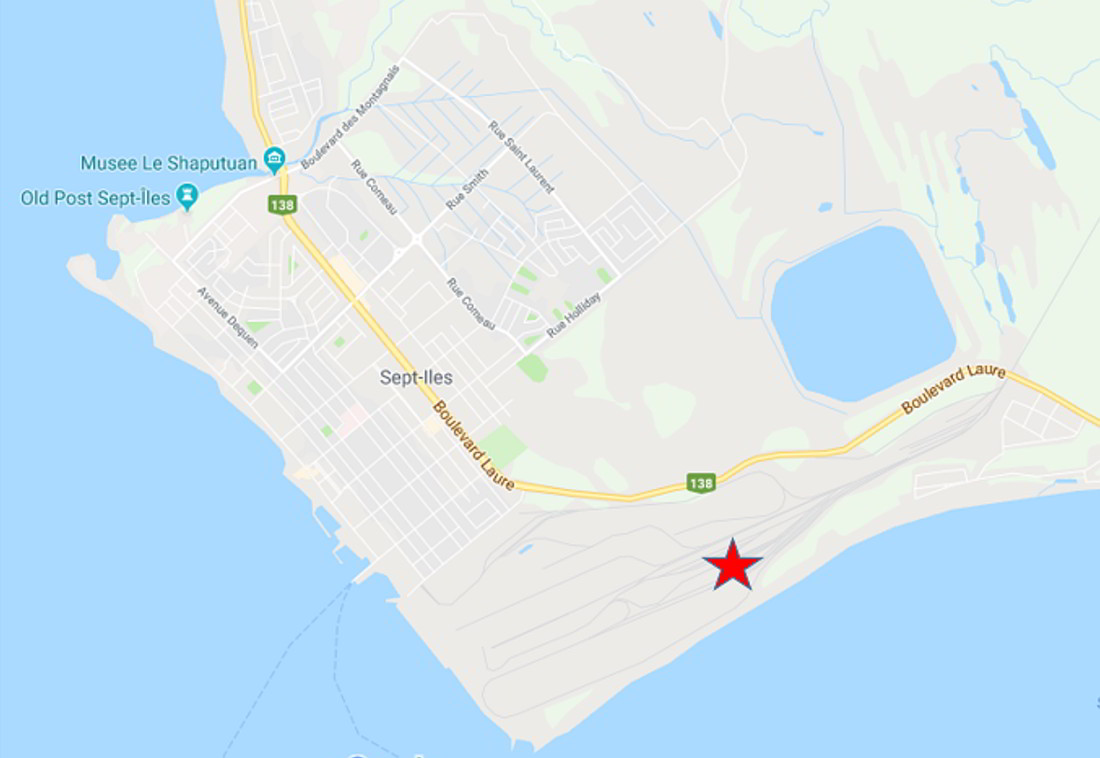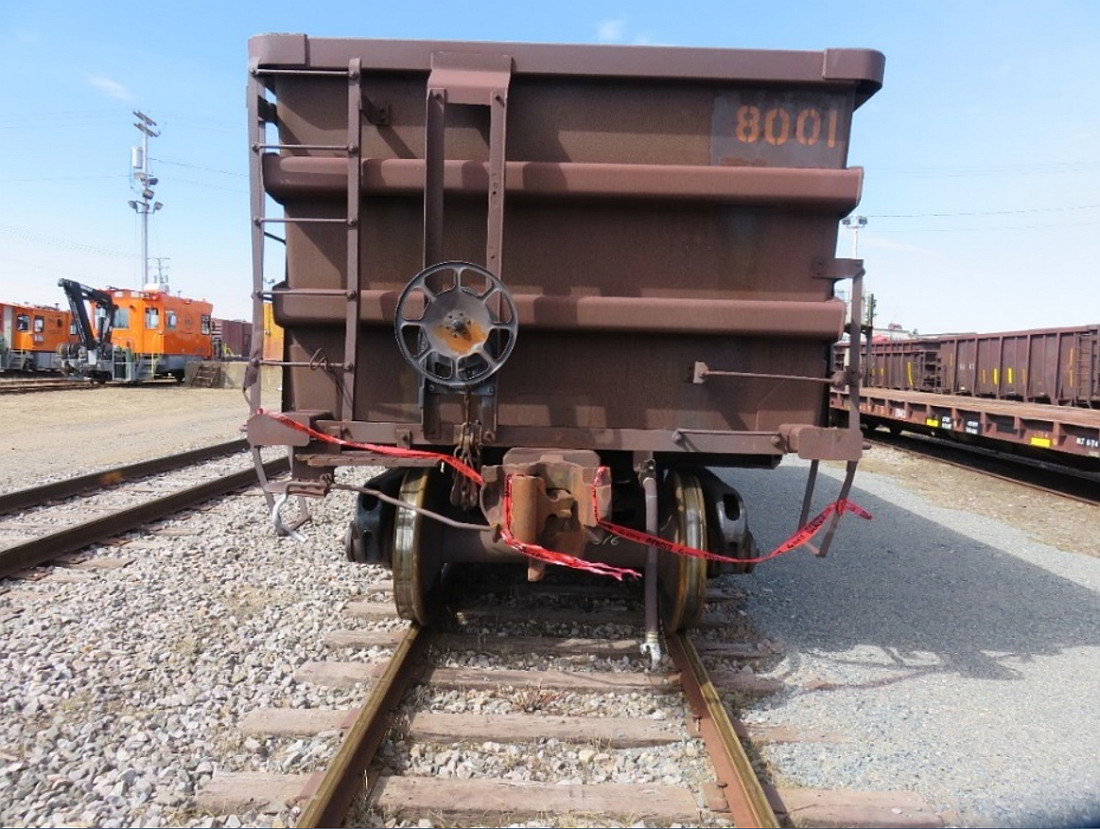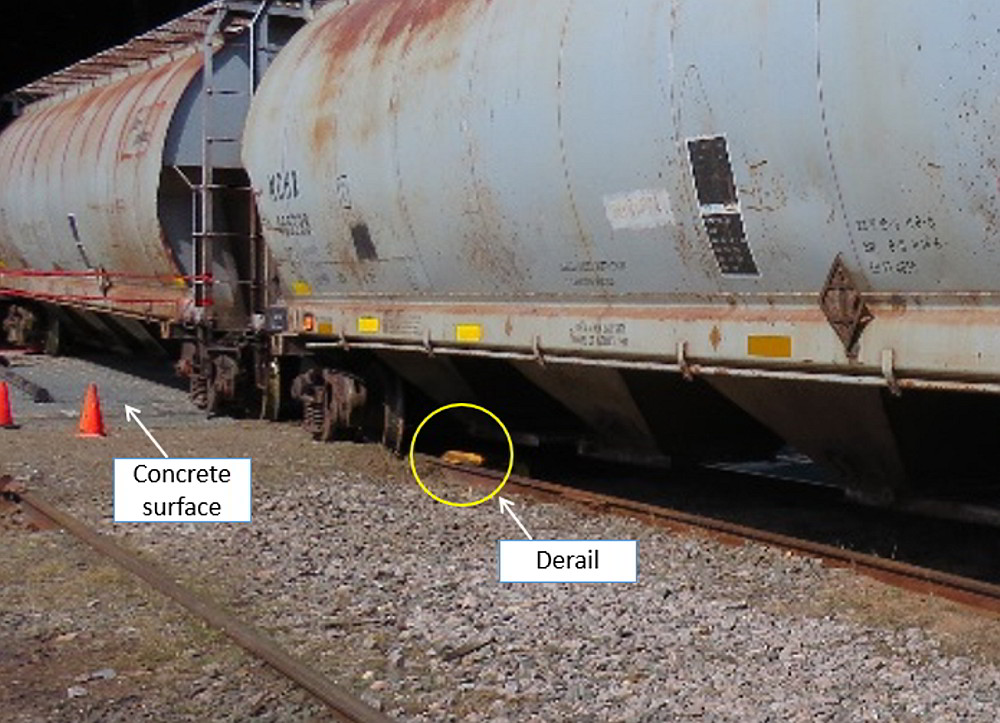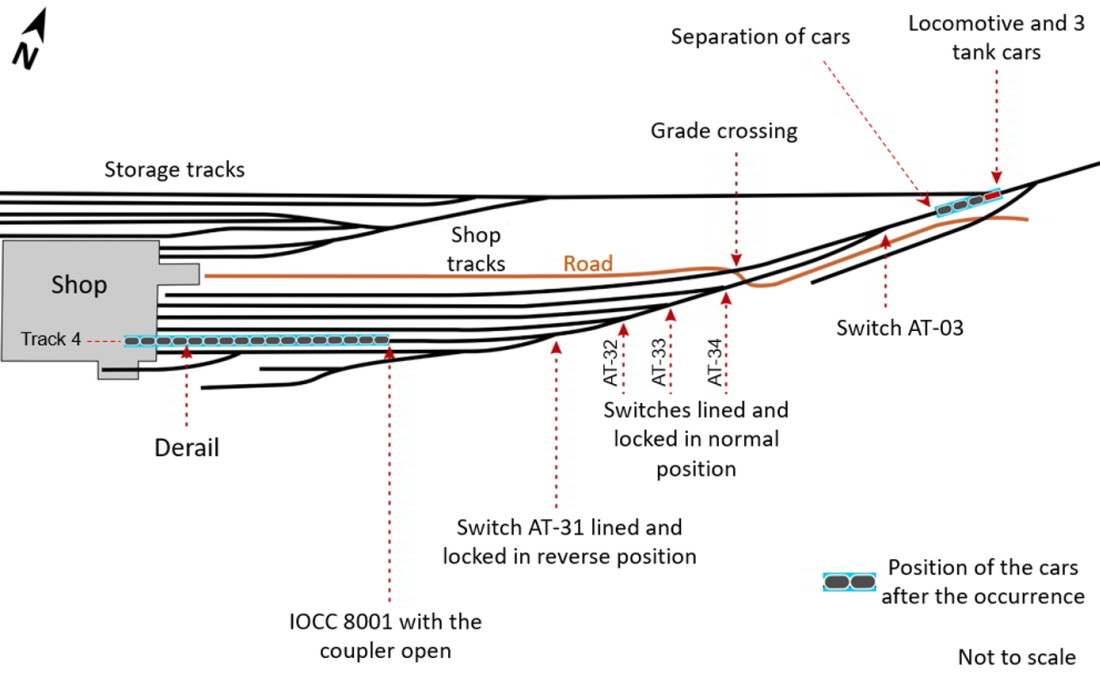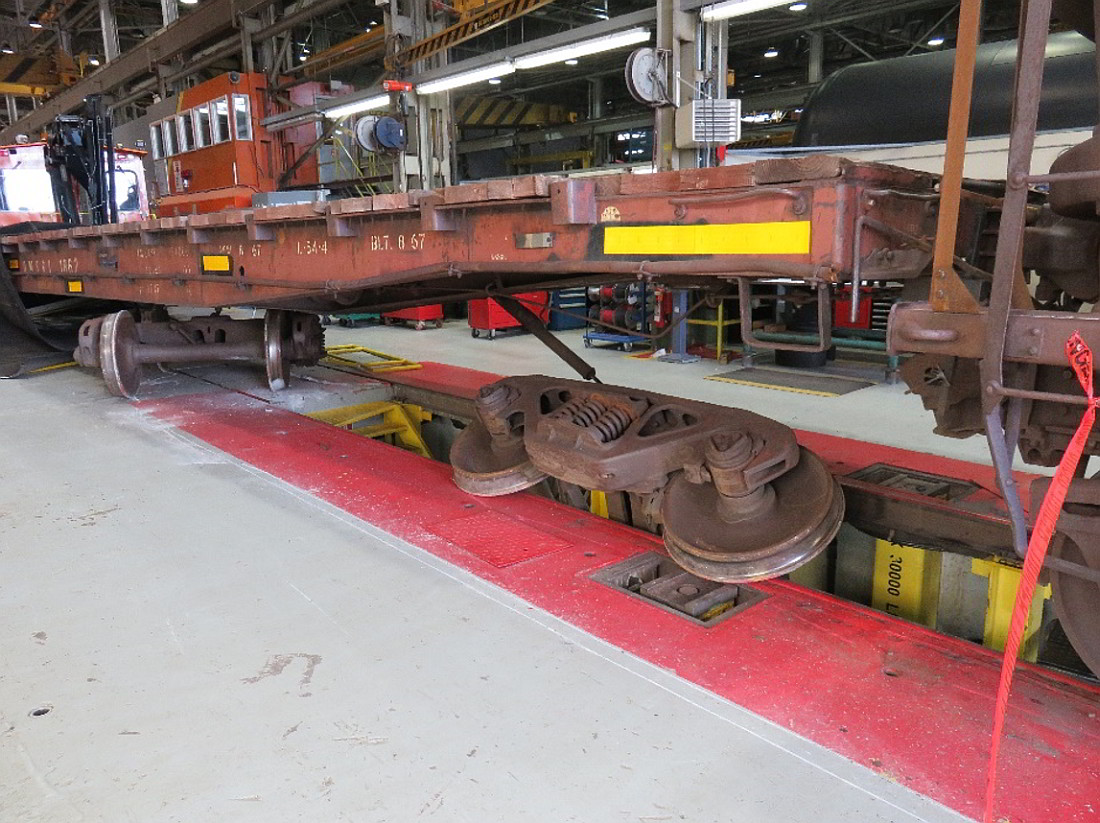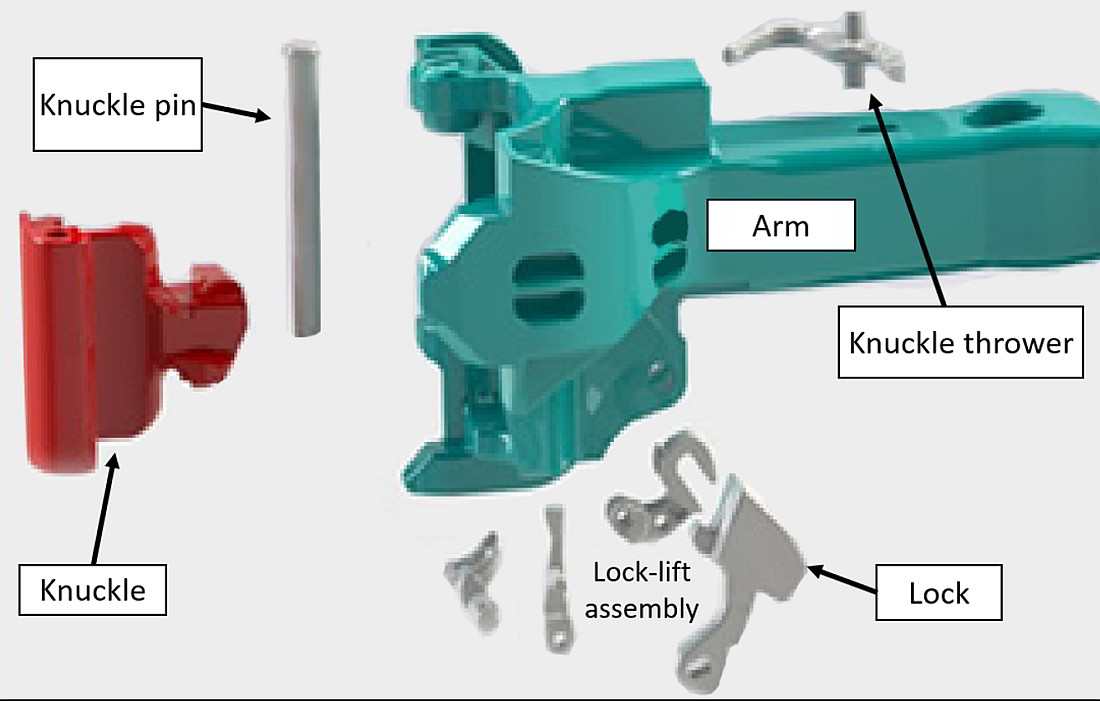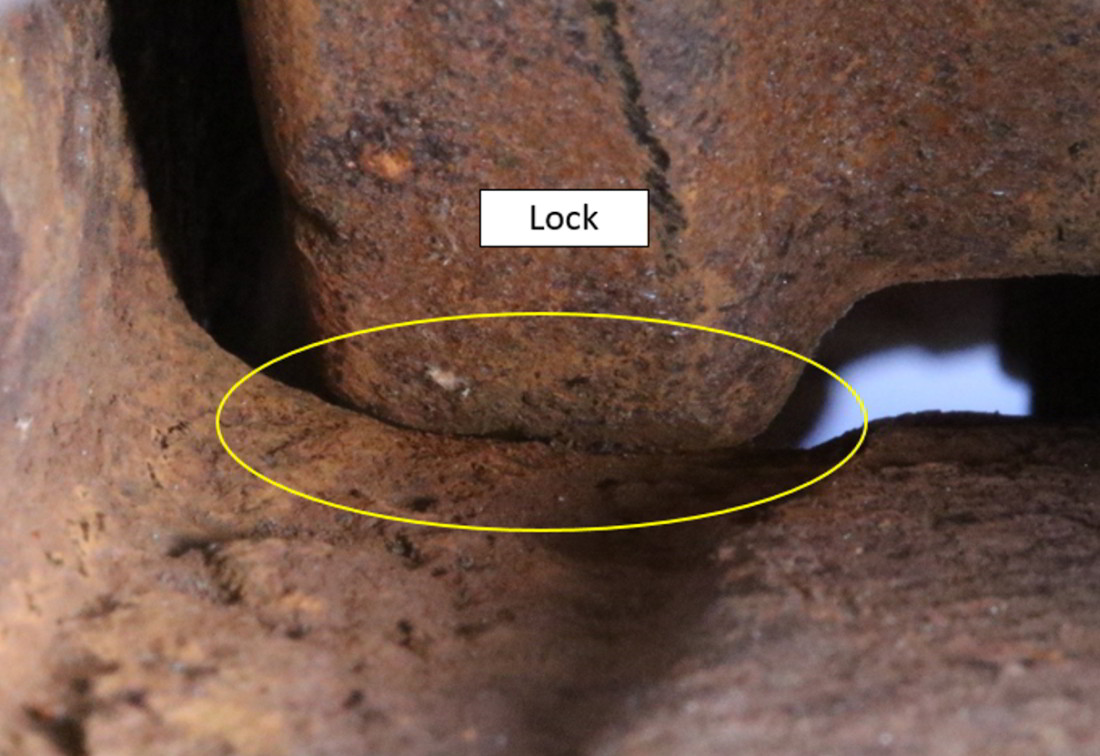Uncontrolled movement and derailment of rolling stock on non-main track
Quebec North Shore and Labrador Railway
Sept-Îles Yard
Sept-Îles, Quebec
The Transportation Safety Board of Canada (TSB) investigated this occurrence for the purpose of advancing transportation safety. It is not the function of the Board to assign fault or determine civil or criminal liability. This report is not created for use in the context of legal, disciplinary or other proceedings. See Ownership and use of content. Masculine pronouns and position titles may be used to signify all genders to comply with the Canadian Transportation Accident Investigation and Safety Board Act (S.C. 1989, c. 3).
Summary
On 01 May 2018, at approximately 1425 Eastern Daylight Time, a cut of 17 empty mixed freight cars uncoupled from a yard assignment train on track AT-03, at the marshalling yard of the Quebec North Shore and Labrador Railway in Sept-Îles, Quebec. The cut ran uncontrolled and headed toward the yard shop. The first 4 cars of the cut left the track, crossed over a sliding derail, and rolled onto a concrete surface. The lead car smashed through the bay door and entered the repair shop. The lead car then struck a parked track unit, which derailed. The cut of cars travelled a total distance of about 1700 feet. There were no injuries. No dangerous goods were involved.
Factual information
The occurrence
On 01 May 2018, at about 1400,Footnote1 a crew of operators was switching cars near the rolling stock repair shop, at the Quebec North Shore and Labrador Railway (QNS&L) Sept-Îles Yard in Sept-Îles, Quebec (Figure 1).
The yard assignment train (the movement) included 1 locomotive, 3 empty tank cars in good condition, and 17 other cars requiring various repairs. The locomotive was set for conventional switching operations. The movement measured about 930 feet long and weighed about 800 short tons. Under the Canadian Rail Operating Rules (CROR), all movements travelling on non-main tracks at Sept-Îles Yard must observe the applicable provisions of Rule 105.Footnote2
At the beginning of the work shift, during a job briefing, the manager and crew members had agreed on the tasks to be carried out. The crew consisted of 4 operators.Footnote3 A qualified operator and a trainee operator were on board the locomotive, and a qualified operator and a trainee operator were on the ground. All of these crew members were qualified for their respective positions, were familiar with switching, and met established rest and fitness requirements.
At approximately 1415, the locomotive and 3 tank cars were coupled to the first car (ore car IOCC 8001) out of a cut of 17 cars parked on a storage track. The crew performed a pull test to check that the cars were properly coupled. The brake pipe had not been charged with air. The movement was then to continue to the Sept-Îles Yard shop to deliver the defective cars on tracks 2 and 3, depending on the space available.
At about 1423, the movement was backing up southward on track AT-03, at about 5 mph, on a descending grade. At 1425, in compliance with the regulatory provisions in effect,Footnote4 the ground operator asked the locomotive operator to stop the movement before the private grade crossingFootnote5 located about 1600 feet to the north of the shop. The empty ore car (IOCC 8001, shown in Figure 2), in 4th position from the head end of the movement, then uncoupled without the crew's knowledge, and the cut of 17 cars ran uncontrolled in a southward direction.
The cut of cars, with flat car QNSL 1862 leading, passed over the grade crossing, veered onto track 4 at switch AT-31, and headed toward the shop. The first 4 cars left the track on a sliding derailFootnote6 installed about 60 feet north of the shop. As required, the sliding derail was locked. The derailed cars proceeded over approximately 20 feet of ballast, remained upright and did not stop. They continued to roll and climbed onto a concrete surface leading to the shop door (Figure 3).
At 1427, lead car QNSL 1862 smashed through the door of bay No. 4, and the first 3 cars entered the shop (Figure 4).
When the ground operator became aware of the uncontrolled movement, an emergency call was issued by radio, about 1 minute after the cars became uncoupled. However, by that time, the cars had already entered the shop.
The lead car rolled beyond a repair pit underneath track 4, struck parked track unit 46Q0802 (causing this unit to derail), and then came to a stop. The cut of cars travelled a total of approximately 1700 feet after they became uncoupled from the movement.
There are multiple tracks that lead to the shop. The switches of turnouts AT-34, AT-33 and AT-32 were in normal position and locked. The switch at turnout AT-31 was in the reverse position and locked,Footnote7 which allowed rolling stock access to track 4. Blue flag protectionFootnote8 is not required on these tracks.
At the time of the occurrence, 14 employees were inside the shop and close to the area of the derailment. There were no employees in the repair pit underneath track 4. There were no injuries. No dangerous goods were involved. The temperature was 5 °C, the winds were calm and the sky was overcast.
Site examination
The 17 uncontrolled cars were coupled to each other and came to rest on track 4. The lead car (QNSL 1862) had left the rails when it went over the derail. It had rolled over a short section of ballast that was contaminated with sand and onto a concrete surface. Its trucks had separated from the platform and the trailing truck had fallen into the repair pit (Figure 5).
The track unit, which had been struck by the lead car, had hit some toolboxes and cabinets next to the track. The next car (IOCC 2689) had stopped above the pit with its lead truck derailed. The 2 trucks of the following car (NCHX 465393) had derailed, and the car had come to rest on the concrete surface at the shop entrance. The last derailed car (NCHX 465398) had stopped with its lead truck derailed. The other cars had not derailed. The last car (IOCC 8001) had stopped about 540 feet north of the shop. The coupler on the north end of the car (the B-end coupler) was in the open position. This car had been stored at Sept-Îles Yard for about 4 monthsFootnote9 during the winter awaiting repairs to the A-end truck.
The door of bay No. 4, made of a thick opaque canvas that limited visibility to the outside, had been ripped off from its mountings and fallen to the ground.
Following the occurrence, the couplers between the 3rd and 4th cars of the movement were visually examined. No defects were observed. Since the coupler on the B-end of the 4th car (IOCC 8001) was open, the assembly was sent to the TSB Engineering Laboratory in Ottawa, Ontario for examination.
Derails
According to the Transport Canada–approved Rules Respecting Track Safety, also known as the Track Safety Rules:
Each derail must be clearly visible. When in a locked position a derail must be free of any lost motion which would allow it to be operated without removing the lock.
Based on the Normes d'entretien de la voie (Track Maintenance Standards) in effect at QNS&L, the installation of derails must comply with a number of criteria.Footnote10 For instance, derails must be installed
- on non-main tracks where rolling stock is likely to move by gravity
- on the entry and exit tracks of the main and running repair shops for rolling stock, at least 40 feet away from the doors
In addition,
- hinge and sliding derails can be used when the speed of vehicles to be intercepted does not exceed 15 mph;
- the derails that are used must be the right model and size, and must be placed on the correct side with respect to the running rail;
- the hinge and sliding derails must be painted yellow; and
- derails must be inspected on a monthly basis.
Other railways have comparable installation standards.
At Sept-Îles Yard, derails are installed on the entry and exit tracks of the repair shop for protection.
Operator training
The QNS&L operators in Sept-Îles Yard must successfully complete CROR and conductor training. They also receive training enabling them to remotely control locomotives in shunting or transfer service. In addition, they can operate locomotives within the Sept-Îles Yard by conventional manner.Footnote11 Additional instructions and on-the-job training allow them to obtain separate certifications for the different areas of Sept-Îles Yard.Footnote12
Switching operations at Sept-Îles Yard
All switching operations carried out at Sept-Îles Yard must comply with the CROR, the applicable General Operating Instructions (GOI), the timetable in effect, and with any other instructions provided in the operating bulletins or circulars.
When a crew has to move cars from one area to another, they must first obtain instructions from the crew leader assigned to the yard's receiving tracks. If a crew needs to enter or exit the designated “shop area,” the crew must communicate with the shop manager and follow the established procedures.
On the north side of the shop, crews stop their movements north of the grade crossing. They must then go to the shop to speak with the shop manager and obtain keys for the switches that need to be operated. The shop manager then instructs the shop employees to suspend their activities until the authorized movement has been parked on the designated track. The maximum speed on the repair shop tracks is 5 mph.
According to the instructions applicable to Sept-Îles Yard,Footnote13 the brake pipe of all movements operating in certain yard areasFootnote14 must be charged with air to enable the use of air brakes. In other areas, such as the shop area, in order to facilitate switching, the use of air was not required.
Radio communications and emergency calls
At Sept-Îles Yard, radio communication channels 11 and 13 are reserved for operator crews, and are not accessible to repair shop personnel.Footnote15 Channel 11, equipped with repeater towers, is the main channel that covers the entire Sept-Îles Yard and allows all operating crews to communicate with each other and with the manager. As a result, this channel is often busy, and communications sometimes overlap. When the channel is busy, operators may have to repeat radio messages and/or ask for clarifications.
Operator crews can also use channel 13 for their communications. This channel is not equipped with a repeater tower and its coverage is limited. When a crew uses this channel, one of the crew members needs to maintain a listening watch on channel 11.
On the day of the occurrence, the 3 crews operating in the yard were using channel 11 exclusively.
At the time of the occurrence, the ground operator observed that the cars were still moving when they should have stopped before the grade crossing. Because channel 11 was busy, he was not able to make the emergency call immediately. Once the channel was free, about a minute later, the operator made the emergency call. By then, the cars had already entered the shop.
Type F coupler
The type F coupler assemblyFootnote16 includes the coupler arm, the knuckle, the knuckle pin, the knuckle thrower, the lock, and the lock-lift assembly (Figure 6).
Couplers are located at both ends of a rail car to allow it to be connected to other cars. When 2 rail cars are coupled together, the coupler knuckle is designed to transition from an open position to a closed and locked position.
When the coupler is closing, the knuckle rotates in a horizontal plane about the knuckle pin, so that the nose of the knuckle engages with the adjoining coupler and its tail retracts into the coupler body. Once the knuckle tail is fully retracted, it is held in place by the lock. The lock then drops between the knuckle tail and the coupler body and prevents the knuckle from opening.
Coupler knuckles are typically opened manually using an uncoupling lever. When the knuckle is opened, as the uncoupling lever is rotated, the lock-lift assembly moves vertically and, in turn, lifts the lock and frees the knuckle tail. As the uncoupling lever rotates further, it forces the leg of the lock to engage the knuckle thrower, opening the knuckle.
Car couplers and their knuckles are inspected and repaired in accordance with the guidelines of Rule 18 of the Association of American Railroads (AAR), by using dimensional gauges. A coupler assembly is considered an “on condition” item. This means that the AAR does not specifically require it to be inspected on a scheduled basis for conditions such as component wear, cracks, deformation or missing parts to ensure that it remains in serviceable condition. A knuckle is determined to be defective if it is worn and/or distorted in excess of the specified dimensional limits.
Examination of the coupler of car IOCC 8001
The B-end of car IOCC 8001 was equipped with a bottom-operated standard type F coupler.
The coupler body was made of Grade E cast steel and manufactured in June 2010 by American Steel Foundries. The knuckle was also made of Grade E cast steel and manufactured in May 2016 by American Steel Foundries. The knuckle lock was Grade E cast steel, with a bottom-operated rotor-action lock.
Examination of the coupler body showed no markings stamped on the horn, indicating that it had not been reconditioned. There was no cracking, no deformation, and no excessive wear present on the exterior of the coupler body. It complied with AAR dimensional and wear standards.Footnote17
The knuckle lock complied with AAR dimensional and wear standards.
During laboratory testing with all the original parts, it was observed that the lower corner of the lock did not drop into the locked position when the knuckle was closed slowly. The lock caught on the back of the locking hole because of accumulated corrosion (Figure 7). This interference prevented the lock from working properly.
TSB statistics for occurrences involving unplanned or uncontrolled movements
Between 2009 and 2018, there were 559 occurrencesFootnote18 reported to the TSB related to unplanned and uncontrolled movements, among all federally regulated railways in Canada (Table 1).
Table 1. Occurrences reported to the TSB involving unplanned and uncontrolled movements between 2009 and 2018
| Reason for unplanned or uncontrolled movement | 2009 | 2010 | 2011 | 2012 | 2013 | 2014 | 2015 | 2016 | 2017 | 2018 | Total |
|---|---|---|---|---|---|---|---|---|---|---|---|
| Loss of control | 0 | 2 | 3 | 0 | 3 | 0 | 1 | 4 | 2 | 5 | 20 |
| Switching without air | 14 | 10 | 16 | 12 | 24 | 21 | 22 | 18 | 21 | 27 | 185 |
| Securement | 37 | 25 | 32 | 43 | 42 | 38 | 35 | 29 | 39 | 34 | 354 |
| Total | 51 | 37 | 51 | 55 | 69 | 59 | 58 | 51 | 62 | 66 | 559 |
Uncontrolled movements generally fall into one of the following causal categories:
- Loss of control – When available air brakes or locomotive systems are unable to hold a train left standing while attended or when an locomotive engineer (LE) or a Beltpack operator cannot control a train when using the available air brakes.
- Switching without air – When a movement is switching using locomotive air brakes only (i.e., no air brakes are available on the cars being switched). When an uncontrolled movement occurs, these situations can result in the cars exiting a yard, siding or customer track and entering onto the main track.
- Securement - When a car, a cut of cars, or a train is left unattended and begins to roll away uncontrolled, usually due to
- no hand brake applied or insufficient number of hand brakes applied; and/or
- a car (or cars) is equipped with faulty or ineffective hand brakes; and/or
- the train air brakes release for various reasons.
Over a 10-year period, among the 559 occurrences, switching without air was the main factor in 185 (33%) of the cases.
Since 1994, the TSB has investigated 31 other occurrences, in addition to this occurrence, that involved uncontrolled movements (Appendix A).
Similar occurrence
In April 2017, in Woss, British Columbia, a cut of 11 cars loaded with logs rolled uncontrolled out of a reload centre.Footnote19 The uncontrolled cars rolled over a derail, re-railed at a switch, continued down the grade, and struck 2 on-track engineering work equipment vehicles. All the rolling stock derailed. Three employees were fatally injured, and 2 were seriously injured.
The investigation determined that the coupler lock mechanism did not fully drop and lock in place; the coupling failed when the partially locked knuckle tail yielded and deformed under load, releasing the knuckle. The TSB determined that, if rail car coupling procedures are not fully described in company instructions and are not systematically taught to operating employees, there is an increased risk that coupling and verification of coupling during switching operations will not always be executed safely and consistently.
Board safety concern
In March 2016, CP 2300 locomotive remote control system (LRCS) training yard assignment was shoving a cut of cars into track F6 at Sutherland Yard, Saskatoon (Saskatchewan).Footnote20 As the assignment was brought to a stop, empty covered hopper car EFCX 604991 uncoupled from the movement without being noticed by the crew. The car rolled uncontrolled through the yard and onto the main track within cautionary limits of the Sutherland Subdivision. The car travelled about 1 mile and went over 2 public automated grade crossings before coming to a rest on its own. There were no injuries and no derailment occurred. No dangerous goods were involved.
The investigation determined that, despite Transport Canada (TC) and industry initiatives, the desired result of considerably reducing the number of uncontrolled movements had not yet been reached. Accordingly, the Board was concerned that current defences were not sufficient to reduce the number of uncontrolled movements and improve safety.
TSB laboratory reports
The TSB completed the following laboratory report in support of this investigation:
- LP103/2018 – Coupler analysis
Analysis
The analysis will focus on the coupler, yard switching operations, derail location, radio communications and emergency calls.
The occurrence
When the coupler from the B-end of ore car IOCC 8001 suddenly opened, the cut of 17 cars ran uncontrolled to the south, leading to the derailment of 4 cars and the collision with a track unit (TU).
The cut of cars headed toward the repair shop and the first 4 cars left the tracks when going over a sliding derail but remained upright. The derailed cars rolled over approximately 20 feet of ballast and then climbed on an adjacent concrete surface about 40 feet long leading to the repair shop. The length and condition of the ballast was not sufficient to trap and stop the derailed cars effectively before they reached the adjacent concrete surface.
The lead car smashed through the door of bay No. 4 and collided with a TU. The first 3 cars entered the repair shop.
Coupler
In this occurrence, when the movement was coupled with ore car IOCC 8001, it is likely that the coupler lock dropped only partially into position due to a lack of clearance caused by accumulated corrosion. It is likely that this corrosion had built up during the period of time when the car was not in use, and was not detected. A coupler assembly is considered an “on condition” item, so the Association of American Railroads (AAR) does not specifically require it to be inspected on a scheduled basis for conditions such as component wear, cracks, deformation, or missing parts. If coupler components are not required to be inspected on a scheduled basis, component wear and other defects may go undetected, increasing the risk that the coupler will not perform as intended.
The pull test that followed the coupling of the movement to ore car IOCC 8001 did not detect that the coupler was not locked. The interference between the lock and the knuckle tail, which was due to the presence of corrosion, was sufficient to prevent the knuckle from opening during the pull test.
When the coupler was subjected to in-train forces during subsequent movements, the engaged edges of the lock and the coupler slipped, causing the release of the lock and the unintended opening of the coupler. This resulted in the release of the cut of cars that ran uncontrolled.
Switching operations at Sept-Îles Yard
All Quebec North Shore and Labrador Railway (QNS&L) locomotive operators at Sept-Îles Yard are required to undertake specific training before being permitted to perform switching operations either alone or in a crew of 2 at Sept-Îles Yard.
At Sept-Îles Yard, all movements operating in certain yard areas must have their brake pipe charged with air. In other areas (including the shop zone where this occurrence took place), it was standard practice not to charge the brake pipe with air, in order to facilitate switching operations. On the day of the occurrence, switching operations at Sept-Îles Yard were being performed while the movement's brake pipe was not charged with air. As a result, the emergency brakes were not available. If the brake pipe of a movement is not charged with air, the emergency brakes will not operate in the event of a train separation, increasing the risk of it running uncontrolled.
Derail location
A sliding derail is designed to force low-speed uncontrolled rolling stock off the running surface of the rails and drop the wheels in the ballast, where they will be trapped and stop. In addition to being of the right model and rail size, a derail must be installed on sound, fully supported ties. According to industry best practices, the entrances and exits of running repair shops must be protected by a hinged or sliding derail installed on every track, no less than 40 feet away from the doors.
In this occurrence, a sliding derail was installed approximately 60 feet away from the shop on the track leading to the door of bay No. 4, in compliance with industry best practices. However, due to the presence of a concrete surface surrounding the shop, there was only approximately 20 feet of ballast available to trap and stop the derailed cars. In addition, the ballast was contaminated with sand. Therefore, the length and condition of the ballast was insufficient to dissipate the kinetic energy of the derailed cars.
Although the leading cars were derailed by the sliding derail, the cars remained upright and continued to roll onto the concrete surface just beyond the derail, allowing them to enter the shop. If a derail is installed at a location where the length and condition of the ballast is not sufficient to dissipate the energy of the rolling stock, the derail may not function as intended, increasing the risk of an accident or injury.
Radio communications and emergency calls
At Sept-Îles Yard, operating crews have 2 radio communication channels for their exclusive use. Channel 11, equipped with repeater towers, is the main channel and covers the entire yard. On the day of the occurrence, the 3 operating crews working inside the yard were using channel 11, which was very busy. As a result, communications often overlapped, rendering some portions unintelligible.
At the time of the occurrence, the ground operator realized that the cars were still moving when they should have stopped before the grade crossing. Given that channel 11 was busy, the ground operator was not able to make the emergency call immediately.
The emergency call was made when channel 11 was free, about a minute later. By then, the cars had already entered the shop.
If emergency calls cannot be initiated in a timely manner, the risk of late notification and response to an emergency situation is increased.
Findings
Findings as to causes and contributing factors
- When the coupler from the B-end of ore car IOCC 8001 suddenly opened, the cut of 17 cars ran uncontrolled to the south, leading to the derailment of 4 cars and the collision with a track unit (TU).
- The first 4 cars left the tracks when going over a sliding derail, remaining upright. The derailed cars rolled over approximately 20 feet of ballast and then climbed on an adjacent concrete surface about 40 feet long leading to the repair shop.
- The length and condition of the ballast was not sufficient to trap and stop the derailed cars effectively before they reached the adjacent concrete surface.
- When the movement was coupled with ore car IOCC 8001, it is likely that the coupler lock dropped only partially into position due to a lack of clearance caused by accumulated corrosion.
- The pull test that followed the coupling of the movement to ore car IOCC 8001 did not detect that the coupler was not locked.
- The interference between the lock and the knuckle tail, which was due to the presence of corrosion, was sufficient to prevent the knuckle from opening during the pull test.
- When the coupler was subjected to in-train forces during subsequent movements, the engaged edges of the lock and the coupler slipped, causing the release of the lock and the unintended opening of the coupler.
- Switching operations at Sept-Îles Yard were being performed while the brake pipe was not charged with air. As a result, the emergency brakes were not available.
Findings as to risk
- If coupler components are not required to be inspected on a scheduled basis, component wear and other defects may go undetected, increasing the risk that the coupler will not perform as intended.
- If the brake pipe of a movement is not charged with air, the emergency brakes will not operate in the event of a train separation, increasing the risk of it running uncontrolled.
- If a derail is installed at a location where the length and condition of the ballast is not sufficient to dissipate the energy of the rolling stock, the derail may not function as intended, increasing the risk of an accident or injury.
- If emergency calls cannot be initiated in a timely manner, the risk of late notification and response to an emergency situation is increased.
Safety action
Safety action taken
After the occurrence, Quebec North Shore and Labrador Railway (QNS&L) conducted an internal investigation and took the following actions:
- Issued Circular No. 18-508 entitled Rolling Stock Switching Operation with Air, which stated that all crews must ensure that rolling stock is charged with air and has sufficient operational brakes (Appendix B).
- Eliminated the separate areas of Sept-Îles Yard so as to standardize operating rules in the yard and foster better overall understanding.
- Implemented new lock-out procedures for the protection of employees.
- Completed an evaluation of all derails and their placement on the tracks leading to the repair shops.
- Initiated a project for the replacement of sliding derails with switch derails.
This report concludes the Transportation Safety Board of Canada's investigation into this occurrence. The Board authorized the release of this report on 31 July 2019. It was officially released on 15 August 2019..
Appendices
Appendix A – TSB investigations involving uncontrolled movements
| Occurrence number | Date | Description | Location | Cause |
|---|---|---|---|---|
| R17V0096 | 2017-04-20 | Non-main track uncontrolled movement, collision, and derailment, Englewood Railway, Western Forest Products Inc., Cut of cars | Woss, British Columbia | Switching without air |
| R16W0242 | 2016-11-29 | Uncontrolled movement, collision and derailment, Canadian Pacific Railway, Ballast train BAL-27 and, Freight train 293-28, Mile 138.70, Weyburn Subdivision | Estevan, Saskatchewan | Loss of control |
| R16T0111 | 2016-06-17 | Uncontrolled movement of railway equipment, Canadian National Railway Company, Remote control locomotive system, 2100 west industrial yard assignment, Mile 23.9, York Subdivision, MacMillan Yard | Vaughan, Ontario | Loss of control |
| R16W0074 | 2016-03-27 | Uncontrolled movement of railway equipment, Canadian Pacific Railway, 2300 remote control locomotive system training yard assignment, Mile 109.7, Sutherland Subdivision | Saskatoon, Saskatchewan | Switching without air |
| R16W0059 | 2016-03-01 | Uncontrolled movement of railway equipment, Cando Rail Services, Co-op Refinery Complex, Mile 91.10, Canadian National Railway Company, Quappelle Subdivision | Regina, Saskatchewan | Securement |
| R15D0103 | 2015-10-29 | Runaway and derailment of cars on non-main track, Canadian Pacific Railway, Stored cut of cars, Mile 2.24, Outremont spur | Montréal, Quebec | Securement |
| R15T0173 | 2015-07-29 | Non-main-track runaway, collision and derailment, Canadian National Railway Company, Cut of cars and train A42241-29, Mile 0.0, Halton Subdivision, MacMillan Yard | Concord, Ontario | Switching without air |
| R13D0054 | 2013-07-06 | Runaway and main-track derailment, Montreal, Maine & Atlantic Railway, Freight train MMA-002, Mile 0.23, Sherbrooke Subdivision | Lac-Mégantic, Quebec | Securement |
| R12E0004 | 2012-01-18 | Main-Track Collision, Canadian National, Runaway rolling stock and train A45951-16, Mile 44.5, Grande Cache Subdivision | Hanlon, Alberta | Securement |
| R11Q0056 | 2011-12-11 | Runaway train, Quebec North Shore and Labrador Railway, Freight train LIM-55, Mile 67.20, Wacouna Subdivision | Dorée, Quebec | Loss of control |
| R09D0053 | 2009-09-09 | Non-main-track collision, VIA Rail Canada Inc. locomotive 6425, VIA Rail Canada Inc. Montréal Maintenance Centre, Montréal, Quebec | Montréal, Quebec | Switching without air |
| R09T0057 | 2009-02-11 | Runaway and Non-Main-Track Train Derailment, Southern Ontario Railway, 0900 Hagersville Switcher, Mile 0.10 and Mile 1.9 Hydro Spur | Nanticoke, Ontario | Securement |
| R08V0270 | 2008-12-29 | Non-Main-Track Train Runaway and Collision, Kettle Falls International Railway, Waneta Turn Assignment, Mile 141.20, Kettle Falls Subdivision | Waneta, British Columbia | Loss of control |
| R07H0015 | 2007-07-04 | Runaway Rolling Stock, Canadian Pacific Railway, Runaway Cut of Cars, Mile 119.5, Winchester Subdivision | Smiths Falls, Ontario | Securement |
| R07V0109 | 2007-04-23 | Non-Main-Track Train Derailment, Kootenay Valley Railway (KVR), 0700 Trail Yard Assignment, Mile 19.0, Rossland Subdivision | Trail, British Columbia | Loss of control |
| R06V0183 | 2006-09-03 | Runaway and Derailment, White Pass and Yukon Route, Work Train 114, Mile 36.5, Canadian Subdivision | Log Cabin, British Columbia | Loss of control |
| R06V0136 | 2006-06-29 | Runaway/Derailment, Canadian National, Freight Train L-567-51-29, Mile 184.8, Lillooet Subdivision | Near Lillooet, British Columbia | Loss of control |
| R05H0011 | 2005-05-02 | Runaway and Main-Track Train Collision, Ottawa Central Railway, Freight Train No. 441, Mile 34.69, Alexandria Subdivision | Maxville, Ontario | Securement |
| R04V0100 | 2004-07-08 | Uncontrolled Movement of Railway Rolling Stock, Canadian National, Train M-359-51-07, Mile 57.7, Fraser Subdivision | Bend, British Columbia | Loss of control |
| R03T0026 | 2003-01-21 | Yard Collision, Canadian Pacific Railway, Car No. HOKX 111044, Mile 197.0, Belleville Subdivision | Agincourt, Ontario | Switching without air |
| R03T0047 | 2003-01-22 | Yard Collision, Canadian National, Tank Car PROX 77811, Mile 25.0, York Subdivision | Toronto, Ontario | Switching without air |
| R99D0159 | 1999-08-27 | Runaway Cars, Canadian National, Mile 69.4, CN Kingston Subdivision, Wesco Spur | Cornwall, Ontario | Securement |
| R98M0029 | 1998-09-24 | Main Track Runaway, Collision and Derailment, Matapédia Railway Company, Canadian National Train No. A402-21-24, Mile 105.4, Mont-Joli Subdivision | Mont-Joli, Quebec | Securement |
| R98M0020 | 1998-07-31 | Main Track Runaway and Collision, VIA Rail Canada Inc. Passenger Train No. 14, and an Uncontrolled Five-Pak Movement, Mile 105.7, Matapédia Railway Company Mont-Joli Subdivision | Mont-Joli, Quebec | Securement |
| R97C0147 | 1997-12-02 | Runaway/Derailment, Canadian Pacific Railway, Train No. 353-946, Laggan Subdivision | Field, British Columbia | Los of control |
| R96C0172 | 1996-08-12 | Main Track Collision, Canadian National, Train 117 and an Uncontrolled Movement of 20 Cars, Mile 122.9, CN Edson Subdivision | Near Edson, Alberta | Securement |
| R96C0209 | 1996-10-09 | Runaway Cars, Canadian Pacific Railway, CP 0700 yard assignment, Mile 166.2, Willingdon Subdivision, Clover Bar exchange track | Edmonton, Alberta | Securement |
| R96T0137 | 1996-04-24 | Runaway of Five Tank Cars, Canadian National, Mile 0.0, Hagersville Subdivision | Nanticoke, Ontario | Securement |
| R96C0086 | 1996-04-13 | Runaway Train, Canadian Pacific Railway, Freight Train No. 607-042, Mile 133.0, Laggan Subdivision | Field, British Columbia | Loss of control |
| R95M0072 | 1995-12-14 | Runaway Cars, Canadian National Train No. 130-13, Mile 0.0, Pelletier Subdivision | Edmundston, New Brunswick | Securement |
| R94V0006 | 1994-01-18 | Runaway Train, CN North America, Mile 175, Grande Cache Subdivision | Latornell, Alberta | Loss of control |
Appendix B – Quebec North Shore and Labrador Railway Circular 18-508
QNS&L issued Circular No. 18-508 on 21 May 2018. It stated the following:
SWITCHING EQUIPMENT WITH AIR
All switching manoeuvers on the QNS&L railway, on the main track as well as non-main tracks, must be done with air applied to the equipment. Running switches or gravity drops, regardless of the location on the railway, are prohibited.
Crew members must ensure that there are sufficient operative brakes available to safely control the movement by performing a running brake test as soon as possible after beginning the switching movement. Automatic brakes must be used to control the equipment when necessary.
Switching must be done carefully and trains, transfers, locomotives and cars must be handled in a manner that will prevent damage to the equipment, to lading or to ramps that can be caused by abrupt starting or stopping.
Coupling speed must not exceed 4 mph.
MOVEMENTS BETWEEN DIFFERENT AREAS
All movements travelling between these areas must have air applied throughout all of the equipment and the last 3 cars must have operative air brakes.
In situations where it becomes impossible to handle the equipment as indicated above, a special permission must be secured from the area Superintendant [sic], following a risk analysis to determine any safety preoccupations.
Circular No. 008, dated 2012-05-24 is cancelled.
Circular No. 15-504, dated 2015-06-17 is cancelled.
END OF CIRCULAR NO. 18-508, DATED 2018-05-21.
